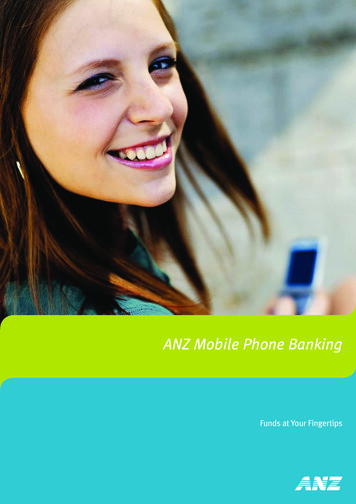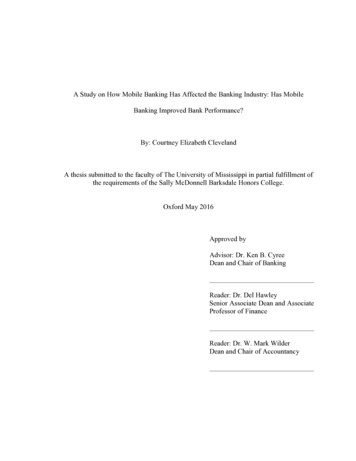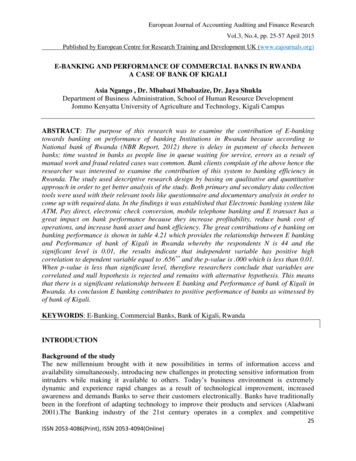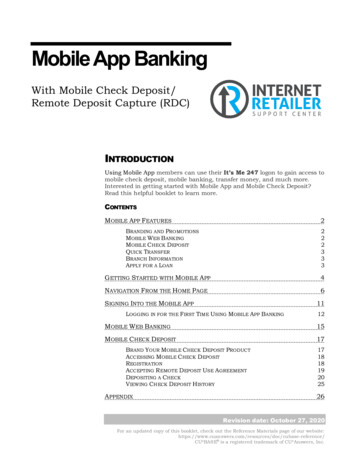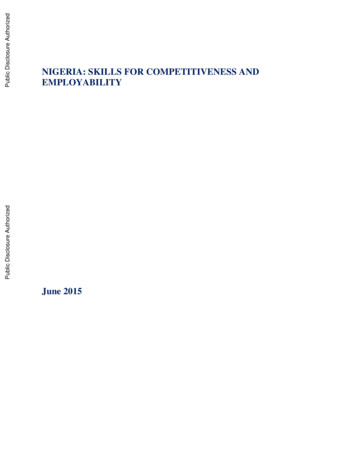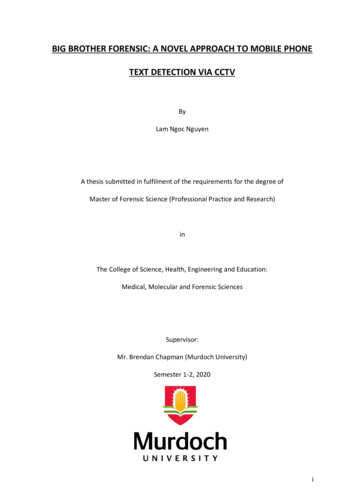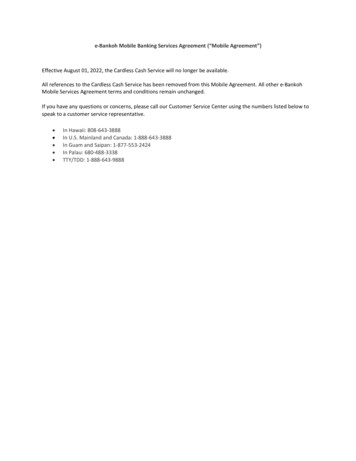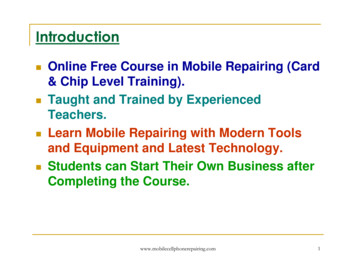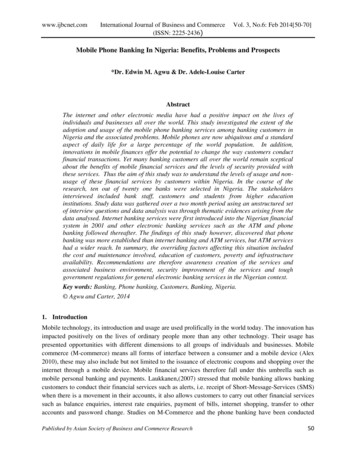
Transcription
www.ijbcnet.comInternational Journal of Business and Commerce(ISSN: 2225-2436)Vol. 3, No.6: Feb 2014[50-70]Mobile Phone Banking In Nigeria: Benefits, Problems and Prospects*Dr. Edwin M. Agwu & Dr. Adele-Louise CarterAbstractThe internet and other electronic media have had a positive impact on the lives ofindividuals and businesses all over the world. This study investigated the extent of theadoption and usage of the mobile phone banking services among banking customers inNigeria and the associated problems. Mobile phones are now ubiquitous and a standardaspect of daily life for a large percentage of the world population. In addition,innovations in mobile finances offer the potential to change the way customers conductfinancial transactions. Yet many banking customers all over the world remain scepticalabout the benefits of mobile financial services and the levels of security provided withthese services. Thus the aim of this study was to understand the levels of usage and nonusage of these financial services by customers within Nigeria. In the course of theresearch, ten out of twenty one banks were selected in Nigeria. The stakeholdersinterviewed included bank staff, customers and students from higher educationinstitutions. Study data was gathered over a two month period using an unstructured setof interview questions and data analysis was through thematic evidences arising from thedata analysed. Internet banking services were first introduced into the Nigerian financialsystem in 2001 and other electronic banking services such as the ATM and phonebanking followed thereafter. The findings of this study however, discovered that phonebanking was more established than internet banking and ATM services, but ATM serviceshad a wider reach. In summary, the overriding factors affecting this situation includedthe cost and maintenance involved, education of customers, poverty and infrastructureavailability. Recommendations are therefore awareness creation of the services andassociated business environment, security improvement of the services and toughgovernment regulations for general electronic banking services in the Nigerian context.Key words: Banking, Phone banking, Customers, Banking, Nigeria. Agwu and Carter, 20141. IntroductionMobile technology, its introduction and usage are used prolifically in the world today. The innovation hasimpacted positively on the lives of ordinary people more than any other technology. Their usage haspresented opportunities with different dimensions to all groups of individuals and businesses. Mobilecommerce (M-commerce) means all forms of interface between a consumer and a mobile device (Alex2010), these may also include but not limited to the issuance of electronic coupons and shopping over theinternet through a mobile device. Mobile financial services therefore fall under this umbrella such asmobile personal banking and payments. Laukkanen,(2007) stressed that mobile banking allows bankingcustomers to conduct their financial services such as alerts, i.e. receipt of Short-Message-Services (SMS)when there is a movement in their accounts, it also allows customers to carry out other financial servicessuch as balance enquiries, interest rate enquiries, payment of bills, internet shopping, transfer to otheraccounts and password change. Studies on M-Commerce and the phone banking have been conductedPublished by Asian Society of Business and Commerce Research50
www.ijbcnet.comInternational Journal of Business and Commerce(ISSN: 2225-2436)Vol. 3, No.6: Feb 2014[50-70]extensively in the developed countries. Some studies have been conducted in Kenya, Tanzania, Zambiaand South Africa for growth in mobile banking, but this is one of the first academic studies in Nigeria, acountry regarded as the most populous country in Africa and therefore the potential for the most mobilebanking.Therefore this study investigates the problems, benefits and prospects associated with mobile telephonebanking services in Nigeria and recommends solutions to financial service managers, policy makers andother practitioners.1.1 Nigeria’s Experience of Mobile Phone TechnologiesThe Global System of Mobile communication, otherwise known as GSM was introduced into theNigerian market in the year 2001. Since the introduction, the demand has rapidly expanded (NCC 2008).Evidence from various researches, as well as published reports of the mobile service operators suggeststhat less than 4.6% of the population had access to the telephone in 2003. Recent reports by the NCC(2013), states that Nigeria now has the highest number of mobile phone subscriptions in Africa - morethan 93 million, representing 16% of the continent's total mobile subscriptions.The report further states that the numbers of subscribers are expanding at about 40% every year, and isforecast to continue over the nest few years. The expansions of the mobile phone market in Nigeria (NCC2013) are linked to the deregulation of the communication sector and interplay of market forces.However, in comparison to other African countries, NCC (2013), stressed that South Africa, with its moredeveloped infrastructure, has the highest broadband penetration - 6%, followed by Morocco with 2.8%.ITU (2011) reports that the telecommunication industry recognises that continued acceptance and usageas well as expansion, will be based on the development of business models that work for poorer people.Mobile phones are increasingly becoming an essential part of the lives of the average Nigerian and otherdeveloping countries of the world (Medhi, et al., 2009) as well as playing a key role such as: A development tool As a household expenditure that maintains social capital and contributes to economicmanagement As an infrastructure – for the improvement of efficiency of markets, and contributing toempowerment As an economic tool for the Nigerian state – as the operators declare huge yearly profits and paytaxes for national developmentPublished by Asian Society of Business and Commerce Research51
www.ijbcnet.comInternational Journal of Business and Commerce(ISSN: 2225-2436)Vol. 3, No.6: Feb 2014[50-70]Table 1: show the growth of mobile phone subscription and penetration in Nigeria between 1998 and2012YearSubscribers 1%201153.7842.08%201259.2449.01%Source: NCC (Nigeria Telecommunication Commission) (2012). Industry Data: Available at:www.ncc.gov.ng. Accessed March 7, 2013Presently, the major telecommunication companies operating in Nigeria are MTN, Globacom, Etisalat,others are Visafone, M-Tel, Intercellular, Multi-Links, BhartiAirtel, Starcomms and Reliance. Table 2shows the percentage market shares of top four operators as at December 2012.Table 2: Percentage market share of top Mobile phone operators in NigeriaMobile phone providersMarket 5201%86,737,028100%Source: NCC (Nigeria Telecommunication Commission) (2013). Industry Data: Available at:www.ncc.gov.ng. Accessed March 7, 2013Quick (2009) stressed that the social uses of mobile phones currently drive the usage among the poor andlow incomes earners. This is because it is used for chatting and keeping in touch with friends andfamilies. Another important key factor driving the growth of mobile phones is that they are indeed„mobile‟ and very much suited to remote areas with poor infrastructures. They also offer an affordableform of communication as a result of the low denomination prepaid scratch cards (Anyasi andOtubu2009). However, beeping and SMS remain the major systems applied in most cases (Quick 2009).Published by Asian Society of Business and Commerce Research52
www.ijbcnet.comInternational Journal of Business and Commerce(ISSN: 2225-2436)Vol. 3, No.6: Feb 2014[50-70]1.2 Mobile Banking: Meaning and BenefitsMobile banking could be defined as a facility which provides banking services such as balance enquiry,funds transfer, bill payment, and transaction history via a user‟s mobile phone (Quick (2009). Segun(2011) defines mobile banking as an occurrence when customers access a bank‟s networks using cellularphones, pagers, personal digital assistants, or similar devices through telecommunication wirelessnetworks. While Akpan (2009) viewed mobile banking (M-banking) as an application of mobilecommerce that enables customers to bank virtually at any convenient time and place, Medhi, et al (2009)believes that the cornerstone of M-commerce is built by M-banking and many banks have takenadvantage of this innovation in order to increase customer satisfactions, manage costs, increase profitsand bring positive transformation of payment system in the economy.Palvia (2009) stated that in 2004, Finland-based Nordea bank experienced a high growth of 30% from theutilisation of transaction-based mobile financial services. Mobile banking as the term connotes is banking“on the move” with the aid of a mobile telecommunication device which can be used for differentpurposes at anytime and anywhere. Mobile banking (M-banking) allows customers to receive shortmessages (SMS) through their phone, wireless application protocol (WAP), and Java enables phonesupport other banking activities using GPRS (General Packet Radio Service) such as direct paymentsconfirmation and funds transfer (Yang 2009).From various literatures reviewed, 30% of households in the United Kingdom (Quick 2009) use theirmobile phones to perform banking operations. Research also shows that the internet has only apenetration rate of 16 % in a population of 140 million in Nigeria, whereas mobile technology is close to50% penetration with prospects for growth (Alex 2010). Mobile devices show promise for the future, andthe ability to reach larger customer populations irrespective of their location, which in turn can lead tocustomer loyalty.Mobile banking has been said to have brought about a positive shift in customers perceptions and thiscould be equally true for Nigeria. Much attention has not been given to the subject matter and there is alack of empirical research on the adoption of mobile banking in Nigeria, so therefore this research aims tobridge the gap in the subject matter. Many researchers have given proof of the advantages that can bederived from using mobile banking services (ITU 2011), which customers can get the benefit of if theyare willing to adopt the facility. Over the years there have been several challenges which the banks havebeen facing regarding poor legacy IT systems and the Mobile Telecommunication System (MTS). Bankscan take full advantage of this new platform for realistic mobile applications which have been madeavailable (Eckhardt, et al 2009).1.3 BenefitsThe benefits attributed to mobile banking (Laukkanen 2007; Eckhardt, et al, 2009) include but are notlimited to: PortabilityLabour freeReduced costConvenienceWider customer reachHigh level of securityAccessibilityPublished by Asian Society of Business and Commerce Research53
www.ijbcnet.comInternational Journal of Business and Commerce(ISSN: 2225-2436)Vol. 3, No.6: Feb 2014[50-70] AvailabilityWhile the above benefits are measured at the individual and organisational levels, the impact of thesuccess of the mobile phone operation within the Nigerian context has added significantly to the GDP,whilst serving as a viable infrastructure to the economy. Table 3 below shows the impact of the mobilephone operation on Nigerian GDP since its inception in 2001.Table 3: Percentage of telecoms to GDP 2001 – 120.62% 0.85% 1.06% 1.27% 1.53% 1.91% 2.31% 2.92% 3.66% 4.56% 5.67% 6.3%Source: NCC (Nigeria Telecommunication Commission) (2013). Industry Data: Available at:www.ncc.gov.ng. Accessed March 7, 20131.4 Banking TrendsiIn Sub-Saharan AfricaThe World Bank (2011) stressed that over the past two decades, Africa‟s banking industry has changedradically. The most important factor driving this change, according the World Bank reports includeadvances in information technology (IT), the deregulation of financial services at the national andregional levels and the effects of globalization process. The reports further states that banking, like mostindustries, has been transformed by technological innovations; these has made it possible to offeralternative channels for services such as ATMs, electronic banking, credit and debit cards and executionof payments through electronic funds transfers at the point of sale (EFTPOS). Africa‟s domestic banks arenow under intense competition from global giants such as Citigroup, HSBC, Barclays Bank, DeutscheBank, UBS AG, etc. Improving access to financial services can contribute to transforming peoples‟ livesin developing countries (NCC 2008). However, the majority of the ordinary people in these countries stillhave limited access to these services. Today, an estimated 2.7 billion people in developing countries haveno access to financial services (World Bank 2009). Over a billion people in Africa, Latin America andAsia are currently without bank accounts; however, only very few have mobile phones.1.5 Internet and Electronic Banking Trends in AfricaThe ITU (2011) report states that Nigeria has overtaken South Africa to become the continent‟s largestmobile market with now close to 100 million subscribers with market penetration at only 60% in early2012; Thulani, et al., (2009) stressed that the majority of the populations in Africa have no access tobanking services, with only 20% of African families having bank accounts. For instance, in 2007, onlyabout 30% of households in Kenya had bank accounts; and in Benin, with a population of 7 million, hadonly 35 bank branches in 2007. Abor (2005) also stated that the limited access to financial services inAfrica stems particularly from deficient infrastructures, physical-geographical isolation or inaccessibility,financial illiteracy, all of which culminate into exceedingly high cost of providing banking services.Ethiopia, Uganda and Tanzania for instance, each have less than one bank branch per every 100,000people compared to 10,000 in Spain. This ratio however shows a high disparity across the continent, withNamibia having more than four, Zimbabwe more than three and Botswana nearly four bank branches per100,000 people. Sub-Saharan Africa (SSA) has the lowest deposit institution penetration in the worldstanding at an average of 16.6% compared to 63.5% in developing countries (Atemnkeng and Nzongang2006).Thulani, et al., (2009) also stated that in the past 30 years, three products that are seen to have had themost impact on the world are in the ICT sector: the internet, PCs and mobile phones. Of these, the mobilePublished by Asian Society of Business and Commerce Research54
www.ijbcnet.comInternational Journal of Business and Commerce(ISSN: 2225-2436)Vol. 3, No.6: Feb 2014[50-70]phone has the highest penetration in developing countries. For instance, between 1998 and 2009, mobilephone penetration in China increased from 1.92 per 100 people to 55.9 per 100; in penetration rates(mobile subscriptions per 100 people) vary from under 10% in Ethiopia to nearly 60% in Gabon, with anaverage of about 33% for the whole continent. The mobile phone revolution continues to leave large partsof the continent behind. While countries like South Africa (88%) and much of North Africa (e.g., Algeria81%) are approaching 93% mobile penetration, in Ethiopia, Burundi, the Central African Republic,Eritrea and Rwanda, it is less than 7%. Low incomes, illiteracy and „large signal black spots‟ are keyobstacles to the acquisition and use of mobile phones.These obstacles are further aggravated by high taxes, which in some countries such as Tanzania andUganda can be as high as 30% of overall charges (Nwosu 2011). Thulani, et al., (2009) further stressedthat the South African banking terrain are dominated by Amalgamated Banks of South Africa (ABSA)Group Ltd; Standard Chartered Investment Corporation Limited, First Rand Holding Ltd (FNB) andNedcor Limited (NedBank). These banks are among other 45 banks and the total branch network wasplaced at 8,495. All these financial institutions offer internet banking services. Internet banking serviceswhich started in South Africa in 1996 was spearheaded by ABSA Bank and other banks followed suit butthe adoption rate has been very slow (Anyasi and Otubu 2009).As a result of high competition among the banks in South Africa, some foreign operators are keen tocherry-pick niche markets (Thulani, et al., 2009). Based on this, loyalty has been thrown overboard ascustomers opt for low price and quality services. South Africa and indeed the African continent are nowexposed to the global financial market forces because of internet technology. Karjaluoto, et al., (2009)pointed out that surviving banks in the present age will need to focus their attention both at home andabroad and use technology to promote their best advantages.In another study, Jahangir and Begum (2008) stated that among non internet banking users, more than56% were not using internet banking services as a result of security issues, and those that are unaware ofinternet banking products and benefits were more than 35%. Although large numbers of people werefound to be ignorant of internet banking services and its benefits, the free training given by some bankshave only had little effect, this is because internet banking is relatively new therefore the diffusion rate islow. As it is in South Africa so it is in most parts of African countries, from Mauritius to Ghana, andEgypt to Zambia, however, the services are not advertised like other products (Thulani, et al., 2009).2. Research QuestionBased on the above, it is necessary to explore the reasons for the lacklustre attitude of Nigerian bankingcustomers towards internet banking services. This led to the research question: How can financialmanagers positively position mobile phone banking in the Nigerian context? A review of the Nigerianenvironment and the banking is deemed necessary in order to understand the state of the Nigerianeconomy, banks and banking.2.1 Nigerian Economic ProfileThe Nigerian economy depends heavily on oil, though other mineral and agricultural deposits abound(CBN 2009). In the same vein, the IMF (2010) report placed Nigeria among the richest country in theworld, the country is also ranked among the major exporters of petroleum products. Despite theseopulence and wealth, the majority of the population lives below the poverty line (UNICEF 2010). 28% ofnew born babies die before the age of three, and basic amenities such as schools, roads, electricity, pipePublished by Asian Society of Business and Commerce Research55
www.ijbcnet.comInternational Journal of Business and Commerce(ISSN: 2225-2436)Vol. 3, No.6: Feb 2014[50-70]borne water, hospitals, etc, are in very short supply (Chukwuemeka 2009). The root cause is often blamedon over 30 years of military rule. According to Okereke (2007), the major causes of these are the lack ofeconomic blueprints by the military personnel. The result is a poor economy, lack of jobs, high crimerates, kidnappings and demand for ransoms by youths and cyber crime. As a result of these, the Nigerianglobal image has been severely dented. Furthermore, Agboola (2006) states that this was as a result of thenew phase of crime nicknamed advance-fee-fraud captioned in section 41.9 in the criminal code, and anexample was the celebrated and well publicized case, captioned: ‘’Nwude, wealthiest ‘’419’’ Kingpin inthe net’’ in various tabloids (Ekenna 2003, p. 23). Based on these and more, the international financialinstitutions view payments such as cheques, electronic payments, and other financial instruments, fromNigeria with caution and some are rejected outright. Soludo (2008) noted that past and presentgovernments have constituted different bodies to fight these corruption from all fronts, the recent beingthe Economic and Financial Crimes Commission (EFCC). Not much have been achieved by this andother bodies, but government oppositions often point to it as a „‟political tool‟‟. The recent consolidationof the banks may be the right step in the right direction with a view to restoring confidence and trust inthe Nigerian financial institutions (Soludo 2008; Central Bank of Nigeria 2009).2.2 Nigerian Technological ProfileThe deregulation of the telecommunication sector and the emergence of mobile phone providers, havebeen lauded home and abroad, as one of the greatest achievements of the immediate past administrationof President Olusegun Obasanjo (Adesina and Ayo 2010). However, it was also noted by otherresearchers that the solid foundation required for the introduction of such an innovation was never inplace especially within the school curriculum, as ICT was not widespread in schools and colleges andeven the universities, neither was electricity, pliable roads, and jobs for the youths (Adogamhe 2010).The usage of mobile phones as opposed to landlines, to which most Nigerian are accustomed, becamedifficult in terms of purchasing handsets. The ITU, (2009) stressed that the basic infrastructures were alsolacking. Hand in hand with this is the epileptic electricity supply with which to charge these mobilehandsets. The epileptic electricity supply initially dissuaded many from purchasing mobile phones(Adesina and Ayo 2010). Chukwuemeka (2009) stressed that Nigeria generates more than 3500megawatts of electricity, which is about 18% of 35000megawatts needed for constant electricity supplyfor the entire nation. This low generation may have accounted for the constant power outages and thepressing need to possess a generating set by businesses and individuals. Akpan (2009, p.3) stressed thatmore than 92% of public and private businesses in Nigeria used generators, a commodity that is rare inthe developed countries. It has however become a norm for any business venture to possess its owngenerator. It is a common site to find public and private businesses with different sizes and shapes ofgenerator; these include the Central Bank of Nigeria, government agencies, banks, and various businessorganizations. It is estimated that Nigeria as a nation spends about N1.95 trillion on generators perannum. The current unsavoury news emanating from government quarters was the idea of Ghana, aneighbouring country, selling electricity to Nigeria from 2015 as a result of a drop in the megawatts asstated above. This is a draw-back for a country that should be self sufficient – however, this was furtherblamed on poor maintenance of the infrastructures (Chukwuemeka 2009). Cost and maintenance ofcomputers and its accessories, according to Alex (2010) tops the list of reasons for lack of interest on newinnovations such as the purchase of computers (desk and laptops). Furthermore, as a result of the level ofincome as well as levels of education in many parts of Nigeria, many see the investment on computersPublished by Asian Society of Business and Commerce Research56
www.ijbcnet.comInternational Journal of Business and Commerce(ISSN: 2225-2436)Vol. 3, No.6: Feb 2014[50-70]and its accessories as white elephant projects. This is as a result of their lack of ability to maintain themwith the epileptic nature of electricity supply.3. MethodologyThe nature of this study requires the collection of both primary and secondary data. Primary data is ofparamount importance for this study due to minimal published literatures in Nigeria on the current issuesof mobile banking adoption. Therefore, there is an essential need to gain first-hand insight knowledgefrom bank managers, business owners, industry professionals, non-bank customers and students to fill thisgap in the literature. Interviews and focus group discussions were chosen over close-ended questionnairesbecause of their adaptability and ability to probe and investigate (Bryman and Bell (2011). However, theinterview questions were pre-tested with a sample of two commercial banks in the United Kingdom andtwo in Nigeria. Suggestions from the aftermath led to a little modification to increase clarity.To maximize the protection of participants in research, Patton (2011) suggests using the guiding ethicalprinciples of informed consent, confidentiality, ensuring no conflict of interest, and avoiding deception.Saunders, et al., (2009) discusses using ethical codes as a way of maximizing protection of participants.The researcher applied all these to the fullest. Participants were apprised of all information relating to theresearch work. This included the reason for the research, where it was to be conducted and over what timeframe, what was involved, and whom it would benefit. All participants were assured of anonymitythrough the use of a coding scheme developed by the researcher to ensure participant confidentiality.Pseudonyms were however used to maintain participants‟ confidentiality. Individuals and focus groupparticipants were identified with pseudo name, i.e. from Participant 1, 2, 3, and so on. Their agreement toparticipate was voluntary and they were free to withdraw any or all their contribution at any point duringthe research process, up until the time the data was analyzed and themed. Upon withdrawal, alldocuments associated with their contributions would be shredded and disposed of in confidential wastemanagement containers. As some of the bank managers who participated might be aware of the customerswho also participated, it was important to address the manager‟s potential anxiety about their participationfor fear that they might come to the bank branches to raise issues relating to internet banking fears andmight end up switching banks. The managers were assured that this is purely an academic activity and assuch should never be a problem with customer relationship.However, it must be made clear that their refusal to participate would never have been an issue and theirparticipation was completely optional. The risk of engaging bank managers and other stakeholders ininterviews is if there is no action or valid contribution from their dialogues. While the message given toparticipants was that the researcher could not guarantee that their ideas will be put into action, it is theresearcher‟ responsibility to ensure that research participants‟ perspectives are linked to the literature andthat the information is presented in a way as to influence change (Easterby-Smith, et al., 2008; Yin 2011).3.1 Data CollectionData for this research was collected from three sources: bank staffs, bank customers and students ofhigher education institutions in Nigeria. Five out the twenty one banks were also targeted and thisincludes interviews and focus group discussions. Data was collected over two months due to the delay inreaching most participants and awkward times stated by the participants, however, the amount of datacollected was enough to reach a workable conclusion with respect to the research aims.Published by Asian Society of Business and Commerce Research57
www.ijbcnet.comInternational Journal of Business and Commerce(ISSN: 2225-2436)Vol. 3, No.6: Feb 2014[50-70]3.2 Data AnalysisYin (2011) suggests one way of handling information analysis is by content analysis or qualitativeanalysis. Saunders, et al., (2009) further stressed that content should be coded under certain themes orquestions being asked. Content analysis was used to categorize information obtained from both the focusgroup and interviews. The techniques used divided comments from bank managers, bank customers andstudents into bold headings and these were then further sub-divided under headings representing thequestions answered. Themed data for the focus group and interviews were then broken down into relevantcomments, contrasting words and ideas, and these emerged as themes. Easterby-Smith, et al., (2008)further stressed that specific types of categorized information should, ideally be consistent and reliable. Inother words, if someone else were to analyze the data, similar themes and categories of informationshould be revealed. The views of Easterby-Smith, et al., (2008) of interpretive qualitative analysis wereadopted by this researcher. This research engaged bank managers, bank customers and students todetermine the reasons for the usage and non-usage of mobile banking services in Nigeria.3.3 Study Sample:The study sample consisted of twenty participants. And these are made up of fifteen interview participants(i.e. five bank staff and ten customers from different occupations) as depicted in Table 4. And a focusgroup discussion made up of five masters‟ degree students.Participant numberName of participantOccupation1Executive Director Retail BankingBank staff2General Manager ITBank staff3Branch ManagerBank staff4Customer Service ManagerBank staff5Marketing officerBank staff6Police officerCustomer7Legal PractitionerCustomer8Business OwnerCustomer9Food sellerNon-customer10Business OwnerCustomer11University LecturerCustomer12Advertising expertCustomer13Secondary School TeacherCustomer14FishermanNon-customer15Petty traderNon-customer16MSc marketing StudentStudent17MBA HRM StudentStudent18MSc Finance StudentStudent19MBA Management StudentStudent20MBA Finance StudentStudentTable4: Profile of participants: 20 (15 interview participants and five masters‟ students for focus groupdiscussion)Published by Asian Society of Business and Commerce Research58
www.ijbcnet.comInternational Journal of Business and Commerce(ISSN: 2225-2436)Vol. 3, No.6: Feb 2014[50-70]4. Information Analysis and Theme DerivationGlesne (2006), Berg (2007), and Stringer (2007) all contributed information on how information gleanedfrom qualitative research should be collated and analyzed
1.2 Mobile Banking: Meaning and Benefits Mobile banking could be defined as a facility which provides banking services such as balance enquiry, funds transfer, bill payment, and transaction history via a user‟s mobile phone (Quick (2009). Segun (2011) defines mobile banking as an occurrence when customers access a bank‟s networks using cellular
